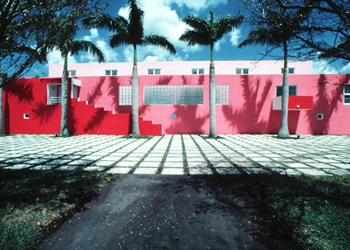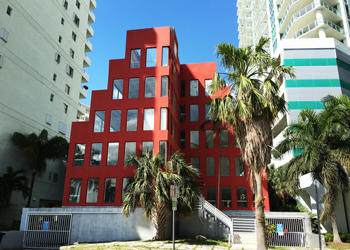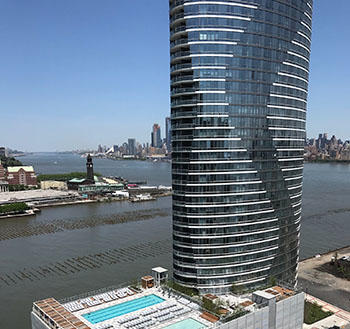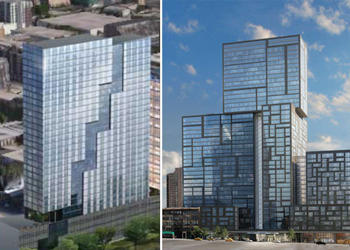Punctuating a montage of palm trees, flamingos and bikini-clad citizens is a building with a hole in the middle of it— missed in a blink. But this seconds-long cameo in the opening credits of “Miami Vice” helped make the condominium’s architect a household name.
Since designing the Atlantis, Arquitectonica has worked on more than 240 projects in the U.S. alone, with another 100 currently in design. In addition to its headquarters in Miami, the firm has regional offices in New York City, Los Angeles, as well as several others in Latin America, Europe and Asia. Some of its notable projects include the Westin Times Square, the master plan for Hudson Yards, the Pink House, the Bronx Museum of the Arts and the East Los Angeles College Performing & Fine Arts School. Upcoming projects include TF Cornerstone’s 606 West 57th Street, a 957,000-square-foot rental tower dubbed “the Max,” and its first large project in Chicago, a 32-story rental tower for Pizutti Companies at 1035 West Van Buren Street. The firm counts Tishman Speyer, Related Companies and Hines among its many repeat clients.

The Pink House (Credit: Arquitectonica)
Last year marked the company’s 40th year in business, with power couple Bernardo Fort-Brescia and Laurinda Spear at the helm. Two of their six children now also work at the firm.
To mark its four decades-worth of work, the firm is releasing a nearly 400-page retrospective in July. Fort-Brescia recently sat down with The Real Deal in his New York City office on the sixth floor of 104 Fifth Avenue to discuss the book and his firm. The monograph, written by Alastair Gordon, notes that every design out of Arquitectonica still starts with a sketch with paper and pen. During The Real Deal’s visit, there was evidence of this: his hands were covered with ink, along with some whiteout that had made its way to his forehead.
You just celebrated your firm’s 40th anniversary. How’s it feel?
We started when we were 23, and therefore, when people think 40th, they think we’re retiring, like, “I didn’t know you were that old!” The other day I got this lifetime achievement award. I mean, my god. The previous person was like 80 years old. We are in mid-career as far as we’re concerned.
You grew up in a family of developers (your grandfather founded Grupo Brescia in Peru). Do you think your knowledge of development gives you an edge with clients?
I understand the numbers. I understand what it takes to put together a building that will work and will get built. Sometimes clients are surprised by how much I know about their business. I lived it for a long time. I think there’s a comfort with a client because they know I know. Or they sense that I understand their plight.
The name of your firm, which is Spanish for architectural, was a bit of an accident. You used it as a placeholder until you could think of something better, but then your first projects got a lot of press. Are you happy that the name stuck?
I’m happy that it’s not my name, or Laurinda’s name, or anybody’s name. I like the anonymity. I like that everybody who works for the firm belongs to the name and doesn’t belong to a personality. We never wanted our names out front. We thought an architectural practice is about the work you do, not the people who do it. Of course, the spelling is complicated, but you know, we survived it. In the end, actually, who cares? It’s the work. If you want to figure out how to pronounce the name of the firm that did it, that’s up to you. It’s been somewhat of a burden sometimes, and sometimes an asset because it’s exotic. It works both ways.

Babylon Apartments (Credit: Phillip Pessar via Flickr)
One of your early projects in Miami, the Babylon, is being demolished. There was quite a controversy over the decision to tear it down. How did you react?
The value of the land was far-exceeding the value of the building. That neighborhood evolved. It’s surrounded by skyscrapers. It looked almost like a holdout. There was a controversy, though, because a lot of people wanted the building preserved. There were people who believe in our work and what it did to transform Miami. There were a lot of buildings of that same year, that same period, that were important in the evolution of our practice. Having said that, we never advocated one way or another. I wouldn’t call myself historic. Other people can.
How did your firm establish itself in Miami?
There’s a saying: right place, right time. And there we were. Before 1980, Miami was a resort and retirement community. A resort for Americans from the cold. In the ’80s, Miami transformed itself into more of an international city. Once we got the first 22-story building, we got a 30-story building, then a 42-story building because the city was growing and the city was changing.
Would you say the appearance of the Atlantis in the opening credits of “Miami Vice” was a game-changer?
Our first buildings were very visible. The Atlantis, good luck if you missed it. You’d have to be blind. If you came on I-95 on the expressway, for at least five minutes that’s all you saw. We had a building that was essentially a billboard for us. It really caught people’s attention, and one of the many who picked up on it was “Miami Vice.” It was a clever move. Television is power. Nothing replaces television. I mean, my god, everybody knew who we were because of the beginning of that show.

The Ellipse, Arquitectonica’s first Jersey City project
After Miami, how did you decide what markets you wanted to expand into?
We never look for markets to expand. We get a call for a project, and it’s in a place we’ve never built anything before. Generally, if you are doing one major project in one place there are other people calling you afterwards. And then it grows from that. We competed for a project in Hong Kong, and we flew there for a presentation. We were the winner, and then of course, since we are very daring and bold, we also opened an office in Hong Kong. It led to an office that’s been there since 1993, and it’s never not had projects. So we’re not sitting here thinking: “Where is the next market that we should be in?” No. If it happens it happens. If there’s another planet out there that someone calls us for a project, we’ll go.
Was it a challenge to break into New York?
No. We were told that non-New York firms never survive. I was warned, but I didn’t listen to the warning.
Of the markets you work in, which is the most challenging in terms of public opinion of development?
There’s always going to be people who disagree, and they are entitled to disagree. But we haven’t had an serious repercussions. Generally, it’s pretty disappointing because we go to a hearing, and we have all these renderings. And then we go to the hearing and the first question is about traffic. The second question is about parking. The third question is about traffic, again. It’s like, when are they going to ask me about the design? A lot of the opposition, unless the building is outrageously unattractive, is about traffic and parking. Of course, in New York, that’s not an issue. And this is not even a discussion in Europe or Asia.
In New York, then, what are you up against?
Change is always a concern of those who live before change occurs. People get attached to a certain way of living. In the new building we’re doing, the Max, it’s over a million square feet, and there was some concern about how we would do a composition of the building. You’ll notice that the building is made of multiple buildings that are sort of piled over each other, teetering, cantilevering over the other one. It’s made of single pieces, but it reads as one statement. That shows you how we navigate.

1035 West Van Buren in Chicago and The Max at
606 West 57th Street (Credit: Chicago Architecture)
You faced some backlash when you designed the Westin in Times Square.
There are traditionalists, and we are not one of them. We’re a little bit of a disruptor. For us, Times Square was theatrical, and the building had to be theatrical. It was a building that was in performance. Maybe there were some people who are more into that corporate world-look, who may have thought this was maybe too theatrical. But we thought it was doing what Times Square is expected to be. Nobody goes to Times Square with the attitude of purity. It’s the opposite. We don’t do work for universal acceptance. We do what we think is right.
How would you describe your style?
Style is a word that is associated with an era of architects setting their style: ‘Everything that I do is angular and set at 45 degrees. Or everything I do is white. Or everything I do is curvy, and that’s my style, and every building is my signature.’ We don’t aspire to be known for a certain style. If there’s a few buildings that appear to be part of a certain style, it’s accidental. It’s because we thought it was the right solution for that building. We see ourselves as beginning our career with every new project. We have to prove ourselves all over again.
Are there any kinds of projects that you won’t do?
Some firms only do large projects, towers. Our office does little projects, big projects. You learn a lot from small projects. You can do a small project and see it in a year. I think it’s healthy to see your dreams become a reality in a short period of time, not just in the long-term projects. We get really irritated when a client tells us, “oh, I didn’t call you because it’s too small for you.” It’s really annoying.
